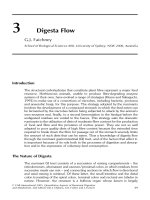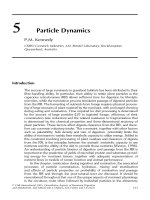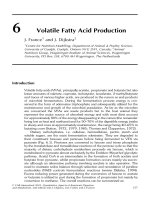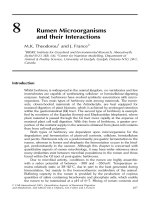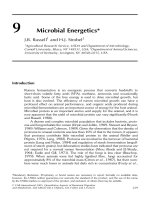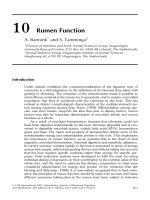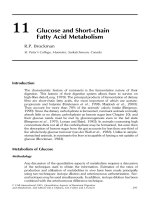Quantitative aspects of ruminant digestion and metabolism - Phần 6
Bạn đang xem bản rút gọn của tài liệu. Xem và tải ngay bản đầy đủ của tài liệu tại đây (187.63 KB, 22 trang )
8
Rumen Microorganisms
and their Interactions
M.K. Theodorou
1
and J. France
2
1
BBSRC Institute for Grassland and Environmental Research, Aberystwyth,
Dyfed SY23 3EB, UK;
2
Centre for Nutrition Modelling, Department of
Animal & Poultry Science, University of Guelph, Guelph, Ontario N1G 2W1,
Canada
Introduction
Whilst herbivory is widespread in the animal kingdom, no vertebrates and few
invertebrates are capable of synthesizing cellulose- or hemicellulose-digesting
enzymes. Instead, herbivores have evolved symbiotic associations with micro-
organisms. Two main types of herbivory exist among mammals. The rumin-
ants, cloven-hoofed mammals of the Artiodactyla, are best equipped for
maximal digestion of plant biomass, which is achieved by prolonged retention
within the gastrointestinal (GI) tract. The second type of herbivory is exempli-
fied by members of the Equidae (horses) and Elephantidae (elephants), where
plant material is passed through the GI tract more rapidly at the expense of
maximal plant cell wall digestion. With this form of herbivory, a greater pro-
portion of the nutrient supply to the animal is obtained from plant-cell contents
than from cell-wall polymers.
Both types of herbivory are dependent upon microorganisms for the
degradation and fermentation of plant-cell contents, cellulose, hemicellulose
and pectin. Ruminants rely on a predominantly pre-gastric fermentation in the
rumen, whereas in horses and elephants the fermentation occurs in the hind-
gut, predominantly in the caecum. Although this chapter is concerned with
quantitative aspects of rumen microbiology, it may have wider relevance since
many similarities exist between microbial populations in the rumen and those
found within the GI tract of post-gastric herbivores.
Due to microbial activity, conditions in the rumen are highly anaerobic
with a redox potential of between À300 and À350 mV. Temperature re-
mains relatively static at 38–428C, due in part to the heat generated during
fermentation, but mainly to the homoeothermic metabolism of the animal.
Buffering capacity in the rumen is provided by the production of copious
quantities of saliva containing bicarbonate and phosphate salts, which enable
the rumen to be maintained at a pH of 6–7. Mixing of rumen contents and
ß CAB International 2005. Quantitative Aspects of Ruminant Digestion
and Metabolism, 2nd edition (eds J. Dijkstra, J.M. Forbes and J. France)
207
some comminution of digesta particles occurs by repeated rhythmic contrac-
tions and relaxations of the rumen wall. However, most of the physical
breakdown of plant biomass is brought about by initial chewing and subse-
quent rumination. Passage of digesta from the rumen is selective and is
based on liquid flow and particle size. The flow of water, solute and small
particles (including microbial cells) through the rumen may take 10–24 h,
whereas larger particles (and attached microorganisms) can be retained
for up to 2–3 days, thus providing time for microbial degradation of plant
fibres.
In return for provision of a relatively constant environment and the con-
tinual supply of plant nutrients, the microbial population in the rumen supplies
the host with easily utilizable forms of carbon and energy and with a protein
source in the form of microbial biomass. The microorganisms, predominantly
fermentative populations of bacteria, protozoa and fungi, are present in
the liquid phase of digesta contents, in association with plant fragments, and
as a lining on the rumen epithelium. Most are obligate anaerobes and will not
grow in the presence of oxygen. Some facultative anaerobes are also present,
and these scavenge available oxygen that enters the rumen with the feed or
by diffusion across the rumen epithelium. Bacteria in rumen liquid are found
at concentrations of 10
9
À10
10
=ml, whereas protozoal populations range
from 10
5
to 10
6
=ml. The population density of rumen fungi (fungal
zoospores) appears to be within the range 10
3
À10
5
=ml. Bacteria are generally
believed to constitute most of the microbial biomass in the rumen, although
estimates of up to 40% have been recorded for protozoal biomass in some
animals. The amount of fungal biomass is thought to contribute less than 8% of
the total.
Over 200 species of rumen bacteria have been described since the pio-
neering work of R.E. Hungate began in the 1940s. All of the principal mor-
phological forms of small bacteria, including Gram-positive and Gram-negative
rods, cocci, crescents, vibrios and helices, occurring singly, in chains, tetrads
and clumps, are found in the rumen. Larger bacteria such as the distinctive
‘Quin’s and Eadie’s ovals’, notable from our inability to grow them in pure
culture, are also represented. The rumen also contains numerous species of
protozoa, most of which do not rely solely on plant nutrients for growth, but
feed by phagocytosis (predation) on rumen bacteria, fungal zoospores and
other protozoa. Of the 100 plus species of rumen protozoa described in the
literature, none are maintainable in axenic culture and only about 20 have been
grown in vitro in the presence of bacteria. Three groups of protozoa are
recognized: the rumen flagellates, the entodiniomorphs and the holotrichs.
The rumen flagellates have been the least studied and some are now considered
to be zoospores of rumen fungi. The rumen fungi are a unique group of
cellulolytic anaerobes whose existence in the rumen was not accepted until
comparatively recently. At least 12 species belonging to six genera have
now been described and this number is expected to increase with continued
research.
208 M.K. Theodorou and J. France
Species Diversity and Activity
Species diversity and the size and activity of the microbial population in the
rumen are not constant, but vary according to changing dietary conditions. In
the wild, this variation is largely a reflection of seasonal and climatic differences
and their effect on the availability, composition and variety of vegetation for
ingestion by ruminants. In domesticated ruminants, however, where conditions
are less variable, changes in diet composition and its physical form are largely
responsible for changes in the microbial population (Thorley et al., 1968;
Mackie et al., 1978). Frothy bloat in cattle can be cited as an extreme case,
where dietary change has a dramatic influence on the rumen microbial popu-
lation. This disorder, occurring soon after the ingestion of certain rapidly
degradable forage legumes, is related to persistence of an extremely high
bacterial population in the rumen dominated by the murinolytic bacterium,
Lachnospira multiparus (Theodorou et al., 1984).
Much of the available energy in ruminant feeds is in the form of structural
plant cell-wall polymers – cellulose, hemicellulose and pectin. Microorganisms
capable of degrading these polymers to their monomeric constituents for
fermentation by themselves or by others are of principal importance in the
rumen. The major species involved in cellulose degradation are Bacteroides
succinogenes, Ruminococcus albus, R. flavefaciens and Eubacterium cellu-
losolvens. These bacteria adhere closely to plant cell-wall surfaces forming
erosion pits as they degrade cellulosic substrates (Chesson and Forsberg,
1997). Recent molecular techniques allow an improved insight into the kinetics
of fibre attachment by rumen bacteria, demonstrating that degradation is not
necessarily synchronized with changes in attached bacterial biomass (Koike
et al., 2003). Hemicellulose is also degraded by some of the cellulolytic micro-
organisms, together with other bacteria such as Butyrivibrio fibrisolvens and
Bacteroides ruminicola (Hungate, 1966; Dehority and Scott, 1967). Fungi
and bacteria contribute most towards degradation of plant cell walls, the
protozoal contribution on the majority of diets being only some 5% to 20%
of total rumen NDF degradation (Dijkstra and Tamminga, 1995). The pectoly-
tic activities of the predominant pectin-degrading bacteria (e.g. B. fibrisolvens,
L. multiparus) and protozoa have been identified (Wojciechowicz et al., 1982;
Williams, 1986), though little has been published on their properties. In
contrast to rumen bacteria and protozoa, the anaerobic fungi exhibit little
hydrolytic activity towards pectin (Williams and Orpin, 1987).
Although absent from plant cell walls, starch is an important
component of many ruminant diets, especially those including grain.
Some cellulolytic bacteria, such as certain strains of B. succinogenes, are
also amylolytic. In general, however, the principal amylase-producing
bacteria, Bacteroides amylopilus, Selenomonas ruminantium and
Streptococcus bovis, have a limited ability to utilize other polysaccharides.
These microorganisms, together with soluble-sugar utilizers such as
Megasphaera elsdenii, occupy a distinct ecological niche in the rumen.
Although they are in competition with many other rumen microorganisms
Rumen Microorganisms and their Interactions 209
for these readily degradable substrates, they survive because of their faster
growth rates or greater substrate affinities (Hobson, 1971; Lin et al., 1985).
Proteins entering the rumen are rapidly degraded with the release of
nitrogen as ammonia. Most rumen microorganisms, with the possible excep-
tion of the main cellulolytic bacteria, are proteolytic to some extent. B. amylo-
philus, B. fibrisolvens, B. ruminicola and the proteolytic Butyrivibriosare
considered to be the major proteolytic species in the rumen (Hobson and
Wallace, 1982). Almost all species of rumen bacteria and fungi, but few
protozoa, can utilize ammonia as a precursor for cellular nitrogen compounds
(Bryant and Robinson, 1962; Wolin, 1979). Competition for ammonia by
rumen microorganisms will only occur in certain situations, notably when the
quality of the feed and dietary levels of N are poor (mainly in the tropics and
subtropics). Rumen bacteria are efficient scavengers of N sources and uptake of
ammonia is represented satisfactorily using saturated kinetics, allowing predic-
tions of optimal levels of N-supplementation when the basal diet is deficient in
N (see review by Dijkstra et al., 2002).
The majority of rumen microorganisms use the Embden–Meyerhof–Parnas
and pentose–phosphate pathways to ferment the hexose and pentose products
of polysaccharide degradation to pyruvate. Pyruvate can then be metabolized in
a number of different ways to various end-products, including formate, acetate,
propionate, butyrate, lactate, succinate, methanol, ethanol, CO
2
and H
2
.In
the rumen ecosystem, however, some of these compounds are present in only
trace amounts, since they are utilized as substrates for growth by secondary
microorganisms. Some examples of bacteria that exist in the rumen by using
the products of primary fermentation include the lactate and succinate utilizing
species, Veillonella paruvla, M. elsdenii and S. ruminantium. As a conse-
quence of their activity, lactate and succinate are converted to acetate or
propionate. Methanogenic archaebacteria such as Methanobrevibacter rumi-
nantium and Methanosacina barkeri utilize either H
2
and CO
2
or formate,
acetate, methylamine and methanol for the production of methane. The in-
volvement of these bacteria in inter-species hydrogen transfer is an important
interaction that alters the fermentation balance and results in a shift of the
overall fermentation from less- to more-reduced end-products (Wolin, 1974).
Although fermentation pathways are well established, the prediction of the type
of volatile fatty acids (VFA) that is produced in the functioning rumen remains a
difficult task (Bannink et al., 2000).
Some of the bacteria that participate in degradation of structural polysac-
charides are unable to utilize all of the products liberated as a consequence of their
activity. Whereas R. flavefaciens produces both xylanase and pectinase, it can-
not utilize the end-products of xylan or pectin degradation (Pettipher and Latham,
1979a,b). Thus, these energy-rich compounds are made available as substrates
for growth of other rumen microorganisms. In a similar case, some of the energy-
rich products of hemicellulose degradation are not utilized by the anaerobic
fungus Neocallimastix hurleyensis that produces them (Lowe et al., 1987;
Theodorou et al., 1989). This apparently altruistic behaviour between rumen
microorganisms has been demonstrated on numerous occasions and is thought to
be related to cross-feeding interactions. In return for the provision of readily
210 M.K. Theodorou and J. France
utilizable substrates, the recipient microorganism provides the primary degrader
with an essential growth factor, such as a vitamin or cofactor. In another example,
the combination of a pectin-utilizing bacterium (B. ruminicola) increased the
degradation and utilization of lucerne pectin (Gradel and Dehority, 1972). In
this situation both organisms benefit from a mutualistic association.
Some microorganisms are able to coexist in the rumen without affecting
the metabolism of others. This situation is comparatively rare and is usually
attributed to highly specialized microorganisms, which have the ability to use
substrates that are not degradable by others. As examples of this type of neutra-
listic interaction, the degradation of oxalate by Oxalobacter formigenes (Dawson
et al., 1980) and 3-hydroxy-4-1(H)-pyridone degradation by unidentified Gram-
negative rods (Jones and Megarrity, 1986; Allison et al., 1987) can be cited.
Protozoa are able to degrade all the major plant biomass for subsequent
digestion within the body of the ciliate, and holotrich protozoa such as Dasy-
tricha and Isotricha can obtain their energy requirements either by uptake of
soluble sugars or via the production of cellulases for degradation of plant biomass
polymers (Hobson and Wallace, 1982; Williams and Coleman, 1997). One of
the least studied but perhaps the most significant interactions in the rumen is that
of predation. Although protozoa are able to utilize plant nutrients, much of their
nitrogen requirements are derived from the phagocytosis of other microorgan-
isms. The role of protozoa in the rumen is not entirely clear and this is due in part
to limited success in culturing these microorganisms in vitro. Alternatively,
mathematical modelling has been applied to examine quantitatively protozoal
biomass and activities in the rumen and interactions (through predation amongst
others) with bacteria (Dijkstra, 1994). In addition, since defaunated animals
remain perfectly healthy, it could be argued that protozoa are not an essential
component of the rumen microflora. However, these organisms can form a
significant proportion of the microbial biomass apparently selectively retained
within the rumen (Michalowski et al., 1986). As a consequence of sequestration
and because of their involvement in predator–prey interactions, the rumen
protozoa undoubtedly affect feed conversion efficiency via the recycling of
microbial cells in the rumen (Dijkstra et al., 1998).
Even minor microbial populations can have a significant effect on rumen
function. The anaerobic fungi are relatively low in numbers in comparison with
cellulolytic bacteria. When fully developed, the fungal thallus consists of one
(monocentric) or more (polycentric) zoosporangia supported by a system of
branched, tapering rhizoids (as in Neocallimastix spp., Piromyces spp. and
Orpinomyces spp.) or bulbous holdfasts (as in Caecomyces spp.). These pene-
trate plant substrates, both for anchorage and to obtain nutrients for growth.
Thus, due to their invasive habit, the anaerobic fungi may escape competition with
faster growing cellulolytic bacteria. Upon completion of the life cycle, the particle-
associated zoosporangium ruptures, liberating zoospores back into the rumen
liquid. These swimming cells have evolved a chemotrophic mechanism that assists
in the search for, attachment to and colonization of freshly ingested plant frag-
ments. The most likely role for rumen fungi is that they participate in primary
colonization of plant cell walls thereby increasing the accessibility of plant frag-
ments to invasion by other microorganisms (Bauchop, 1979a,b). Indeed, in
Rumen Microorganisms and their Interactions 211
co-cultures the fungal mode of attack reduces mechanical resistance of particles,
allowing increased bacterial attack on those damaged particles and possible
coexistence of fungi and bacteria (Dijkstra and France, 1997; Fonty et al.,
1999). In addition to degrading plant cell walls, these microorganisms can also
utilize certain soluble sugars, starch and proteins, but not pectin (Orpin and Joblin,
1988).
Although it is essential in rumen microbial ecology to obtain knowledge of
which species are present and of their activities, traditional methods have
limited applicability. Despite major improvements in isolation or cultivation
strategies, only a minority of the rumen microorganisms have been described
in pure culture. Total viable counts are usually much lower than total micro-
scopic counts (Zoetendal et al., 2003). The majority of microbial species
cannot be obtained in culture and have only been detected using molecular
detection methods (Amann et al., 1995), with an estimated culturability of
bacteria in the total GI tract of some 10–50%. To date, the majority of
molecular studies of microbial ecosystems have been focused on the character-
ization of the community structure or identifying the bacteria in the rumen.
More important, however, is the study of operation and interaction of different
organisms. To achieve this, a promising way forward is to measure the expres-
sion of functional genes.
The above account is an overview and the reader is referred to Hobson and
Stewart (1997) for a more detailed description of the rumen ecosystem and the
various species of anaerobic and facultative bacteria, protozoa and fungi found
therein.
Growth Characteristics
The growth characteristics of a microorganism are generally defined in terms of
various parameters: specific growth rate m (per hour) or biomass doubling time,
growth lag L (h), growth yield, maximum biomass, metabolic quotient for
substrate utilization q
i
[mg substrate i/(mg biomass)/h] and for product forma-
tion and substrate affinity. Most of these parameters are usually determined
from the growth of an axenic batch culture consisting of a well-mixed batch of
inoculated medium. Parameters that cannot readily be determined in this way
are generally obtained using a chemostat. The requisite conditions for biomass
growth in culture are: (i) a viable inoculum; (ii) an energy source; (iii) nutrients to
provide the essential materials for biomass synthesis; (iv) absence of growth-
preventing inhibitors; and (v) suitable physicochemical conditions (Pirt, 1975).
If these conditions are met and provided substrate concentrations are non-
limiting, the following N þ 1 differential equations describe the dynamic be-
haviour of the batch culture:
dX=dt ¼ 00 t < L (8:1a)
¼ mXt! L (8:1b)
212 M.K. Theodorou and J. France
dS
i
=dt ¼ 00 t < L (8:2a)
¼Àq
i
Xt! L (8:2b)
where t (h) denotes time since inoculation, X (mg) is the amount of biomass at
time t and S
i
(mg) is the instantaneous quantity of substrate i, where
i ¼ 1, 2, ..., N. For constant m, integration of Eqs (8.1a) and (8.1b) gives:
X ¼ X
0
0 t < L (8:3a)
¼ X
0
e
m(tÀL)
t ! L (8:3b)
where X
0
is initial biomass, therefore biomass obeys the law of constant
exponential growth. Logarithmic transformation of Eq. (8.3b) yields:
ln X ¼ ln X
0
þ m(t À L) t ! L (8:4)
Thus the plot of log biomass against time (! L) is a straight line whose
slope equals the specific growth rate m. The growth lag L can also be deter-
mined graphically by extrapolating this straight line back to the initial biomass
level and reading off the intercept on the time axis. Values of m determined
in this way by Russell and Baldwin (1978) for rumen bacteria grown on a
single energy substrate in a defined medium are presented in Table 8.1.
Corresponding values for L appear to be in the range 0–2 h, mostly nearer
to 0 than 2 h.
The doubling time t
d
(h) of the biomass is found by setting X ¼ 2X
0
and
t ¼ t
d
in Eq. (8.4) and rearranging:
t
d
¼ (ln2)=m þ L (8:5)
For example, the doubling times (from the commencement of growth) of the
rumen bacteria grown on glucose shown in Table 8.2 range from 0.34 h for S.
bovis to 1.78 h for B. fibrisolvens. The ratio X=X
0
represents the degree of
multiplication and is equal to e
m(tÀL)
, t ! L (see Eq. (8.3b)). Alternatively, this
ratio can be expressed as 2
n
, where n is the number of doublings or gener-
ations that the biomass has undergone, giving:
Table 8.1. Specific growth rates for rumen bacteria on single substrates.
Specific growth rate (per h) in
Species Glucose Maltose Sucrose Cellobiose Xylose Lactate
S. ruminantium 0.72 0.35 0.67 0.06 0.64 0.15
B. ruminicola 0.56 0.52 0.62 0.20 0.04
B. fibrisolvens 0.39 0.54 0.52 0.53 0.45
S. bovis 2.04 1.85 2.10 1.83
M. elsdenii 0.45 0.55 0.14 0.21
Rumen Microorganisms and their Interactions 213
n ¼ [ln(X=X
0
)]= ln 2 (8:6)
The growth yield parameter provides a means of expressing the nutrient
requirement of a microorganism. Growth yield with respect to substrate i, Y
i
[mg biomass/(mg substrate i)], is defined by:
Y
i
¼ÀdX=dS (8:7)
For constant Y
i
, integration of Eq. (8.7) yields:
X ¼ X
0
þ Y
i
(S
i
,
0
À S
i
)(8:8)
where S
i
,
0
denotes the initial value of S
i
. Hence, if the culture volume remains
constant, a plot of biomass concentration against concentration of substrate i
should be a straight line with slope Y
i
. Some yields estimated for glucose by
Russell and Baldwin (1979a) are shown in Table 8.2, though we note that these
were estimated using chemostat rather than batch culture. For a growth-limit-
ing substrate S
i
, biomass reaches its maximum X
1
when S
i
reaches zero.
Equation (8.8) gives:
X
1
¼ X
0
þ Y
i
S
i
,
0
(8:9)
The growth yield and specific growth rate are related by the metabolic quotient:
q
i
¼ m=Y
i
(8:10)
This can be shown by dividing Eqs (8.1b) by (8.2b) to give:
dX=dS
i
¼Àm=q
i
(8:11)
and comparing Eqs (8.7) and (8.11). Equation (8.10) can be used to estimate
the demands for substrates at different growth rates. For example, values of
q
glucose
for rumen bacteria obtained from Tables 8.1 and 8.2 range from 1 to
5.1 g/(g biomass)/h.
Table 8.2. Theoretical maximum growth yields on glucose for
rumen bacteria (derived from double reciprocal plots of yield
against dilution rate).
Species Yield (mg biomass per g glucose)
B. fibrisolvens 0.4
B. ruminicola 0.5
M. elsdenii 0.46
S. bovis 0.4
S. ruminantium 0.58
214 M.K. Theodorou and J. France


